Long-term testing is a tricky proposition. Products that seem good during initial testing can turn sour a few months or uses later. Products that don’t seem to shine brightly on first look can go on to be tried and trusted performers. Other times, a good product is undercut by a single faulty feature, and sometimes that feature can be repaired or circumvented. Sometimes products are discontinued, modified, or upgraded after a review.

In any case, for a publication that tries to give readers a thorough look at similar items competing in the marketplace, keeping products in accurate focus over a long period of time can be a bear. Over the years, weve found various ways to update our views. The best way, always, is to publish letters from readers who have had longer experience with particular products than we do. We also have occasionally run a column called “Gear Graveyard.” And once in a while, we just round up products that have or havent stood the test of time. This is one of those roundups.
All of the items mentioned here are, or have been, in use aboard either a 26-foot biodiesel-powered inboard powerboat or a 32-foot Union cutter, two of five different boats that we regularly use to test products. They are among quite a few items aboard that undergo testing and abuse, formal and informal, intentional and unintentional.
Plastimo water tank
Reviewed October 2007
Flexible water tanks are a convenient solution for several water-storage problems. But are they tough enough? PS was really brutal to tanks from Vetus, Nauta, and Plastimo, reporting results in the October 2007 issue. The Plastimo got the Best Choice rating. The tank reviewed in the article was the 13.2-gallon unit, Plastimo part number 18031. We ordered and installed a larger model, Plastimo (part number 18033), a 26-gallon tank. Using an electric pump, we pumped fresh water through a garden hose and sprayer to use as a cockpit shower.
After three seasons of use and approximately 20 fillings, heres the good news and bad news:
Good news:
The plastic tank is structurally sound; there are no breaches or leaks. The anti-chafe cover is sound. The fill and outlet fittings are sound and O-rings still intact. Its convenient to be able to see water levels, with no need for a tank vent. We like being able to remove the tank from the boat, clean it, and store it dry in the winter months.

Bad news:
The translucent tank is showing spots and stains from algae inside that cannot be easily removed; we clean the tank annually with a solution of hot water and vinegar. We have found it difficult to keep the outlets (centered on one side for discharge and in a corner on the opposite side for fill) aligned with their holes cut in the anti-chafe cover. We now just rest the tank on top of the cover, which protects against abrasion from raw fiberglass in the bilge, where the tank is secured.
On balance:
This tank is tough enough to be considered for permanent installation, and its nice to be able to empty it, disconnect it, clean it, and hang it up at the end of the season. Wed buy it again.
Seoladair Easystow inflatable fender
Reviewed July 2008
The Easystow was named Best Choice in the original PS review of inflatable fenders. The fender reviewed in the article was the 10-inch by 36-inch fender model FH1036 (currently $109). We ordered and installed a larger model, Seoladair part number FH1060, the 10-inch by 60-inch heavy-duty fender ($149). The fender has been in use as the test boats primary fender, both in the slip and rafted up with other boats, since July 2008. Thats 18 months of in-season use, plus a bunch of winter months deflated and left in the covered boat.
Good news:
This fender is light and easy to work with. It takes the place of two cylindrical or ball-type fenders. The blue material doesn’t develop the gummy substance that affects poly-plastic fenders in hot weather that can stick to and mar a gelcoat. The valve arrangement is dirt-simple. You fold the rubber blow-tube the way you would a garden hose without a nozzle, and tuck it inside a fabric patch on the fender.

Bad news:
We now have slight wear in the webbing loops that suspend the fender from a braided rope pendant. There is slight chafe on the outside surface of the tube that lies constantly against a wooden slip rail. The air in the fender expands in hot weather and makes it extra firm, and in cold weather it deflates a bit. We have found a happy medium and seldom make adjustments. You must make sure the folding valve is secure.
On balance:
After three seasons of constant use, we think this fender exhibits very reasonable wear and tear, and look forward to using it for years to come. When the webbing loops get too frayed, we can flip the fender bottom-for-top and start over with the unused loops. This will also put the abraded side of the fender against our topsides and a fresh surface against the harsh wooden dock. Eventually, we may sew on new webbing loops to the roots of the old ones.
Garmin GPSMAP 545s
Reviewed October 2008
With new touchscreen technology, this small (5-inch screen), button-controlled chartplotter, reviewed only two years ago, will probably soon seem archaic. As of presstime, the 545s seems to have slipped from the front rank on Garmins webpage, but is still listed on the website, and is widely available at prices much reduced from the one we paid.
Note that this is the chartplotter with the depthsounder option (thus the “S”).When testers installed ours, we needed to have a custom cable made to link an Airmar through-hull depth/temp transducer, already installed, directly to the Garmin plotter/sounder, bypassing a black-box connection set up for a first-generation Furuno NavNet system. For this project, we got in touch with Gemeco, a subsidiary of Airmar located in Lake City, S.C. We sent Gemeco digital photos of the connections we had and the ones we needed, and the cable arrived in a couple of days. The whole setup has worked well for 2 seasons.

Good news:
This has been a rugged and reliable device in a boat that takes a fair amount of wave punishment. We mounted ours without the external antenna, and it has no trouble gaining and holding lock through a 1-inch composite-core cabintop. We have found the BlueChart vector cartography very accurate in our local (Long Island Sound)waters. As with any vector cartography, labels don’t always appear where you expect them and change position at different zoom levels. Theres always a correct position, but the user has to know to change zooms until the place name is positioned logically.
Bad News:
The buttons have gotten a bit sticky. The plotter can get quite hot to the touch in warm weather if theres no breeze circulating around it. Upgrading the cartography is expensive-$100 in this case. And as is true with most electronics, no matter how much we like what we have, we tend to get the fever for the new, improved models.
On balance:
Wed buy it again, but if there were touchscreen models within, say, 15 percent of the same price, wed upgrade.
Coleman thermoelectric cooler
Reviewed June 2003
Thermoelectric coolers use the Peltier effect: An electrical current is passed through the joint between two dissimilar metals; heat passes from one metal to the other, and the heat is then pumped out of the enclosure. Although they are the least efficient form of refrigeration technology used today, these 12-volt coolers are used in a lot of arenas-camping, traveling, long-haul trucking, and boating. They generally will cool their interiors to about 40 degrees lower than the ambient temperature.
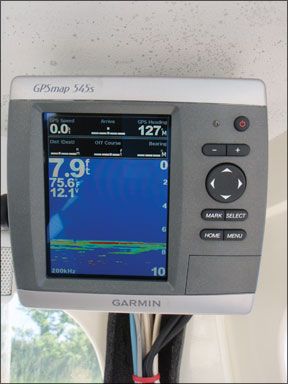
The Coleman Power Chill 5640B was one of four thermoelectric coolers tested for the June 2003 issue. It did well in the testing, but was passed over in favor of the Adler-Barbour Tropicool TC-32, which doesn’t seem to be available. (PS also tested portable compressor-driven fridges in April 2007.) One gripe about the Coleman was that it was just too big for most sailboats at 40 quarts, and Coleman didnt make a 32-quart cooler. Also, it lacked any kind of lid lock.
Nevertheless, this cooler has been in service off and on ever since, and in frequent use for the last few years aboard the 26-foot test-boat. When the boat is in the slip, the cooler serves as a dry locker. When the boat is underway, the cooler is plugged in to a 12-volt socket, and does a good job of preserving block and cube ice for days. It draws 4.7 amps, so it is not left on when the engine is off.
Good news:
With only one moving part-the plastic impeller fan that pumps the warmth out of the box-theres little that can go wrong with the machine. The box itself is sturdy and can be used as a seat.
Bad news:
None of the metal parts on land-oriented coolers like this one does well in a salty marine environment. The latch plate is rusty, the prongs and sockets that attach the 12-volt cord to the dongle on the box (which allows either warm or cool air to be pumped from the box) need regular cleaning and WD-40, and weve had to replace the 12-volt plug.
Care must be taken not to place things against the cowling that protects the impeller and vents the warm air. Its flimsy, and can stop the fan. It appears that the updated model of the cooler uses an improved design.
Theres not enough insulation in the box itself to maintain temperatures inside for long without power. This is true of refrigerators ashore, too, where insulation has been given up in favor of more interior volume, with electricity making up the difference.
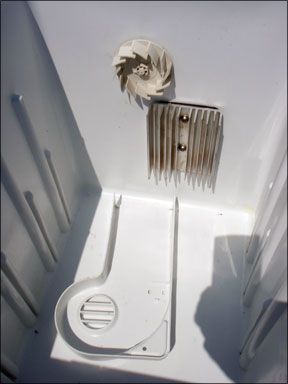
On balance
For people on a tight budget who don’t care too much about efficiency, a thermoelectric cooler can be a good substitute for ice. While this one has done pretty well for us, we would see if any other makes or models have a smaller footprint, more insulation, and a good latch.
Jabsco oil changer
Reviewed January 2007
Anything that can help eliminate the spills and messes of oil changes is a good thing. The best way to get dirty oil out is to pump or drain it directly from the bottom of the pan sump into a secure container. But the best way is often impossible, so many of us pull the oil up out of the pan through the dipstick bore. This Jabsco oil-changer, made of a 4-amp oil-resistant diaphragm-pump mounted on a 3.5-gallon polypropylene tank, simplifies this job, eliminating mess and making it easy to get the used oil to the recycling center or transfer station. We have used the oil-changer for four seasons, pumping both engine and transmission oil with it. Thats not the kind of use it would get in a commercial setting, but most pleasure-boat owners only change engine oil once or twice a year.
Good news:
All the parts, including wiring, battery clamps, dipstick tube, pump, and tank, are in good shape. Nothing to report.
Bad news:
The set-up would be bulky to carry aboard, and theres no particularly neat way to stow the 8-foot-long dipstick tube, which is hard to clear entirely of oil. When using a dipstick tube, you need to adjust the probe carefully to avoid curling the tube back up and out of the oil in the sump. Its hard to get all of the dirty oil out-a problem for perfectionists. This is not, however, the Jabsco oil-changers fault.
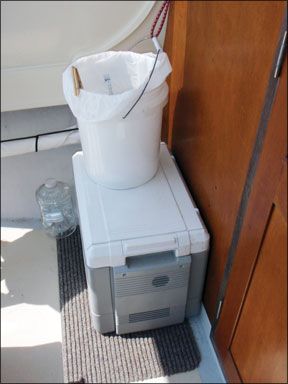
On balance
This setup has made oil-changing much easier, faster, and neater-not a pleasure, but hardly a pain. Wed buy it again.
Firefly 2 strobe
Reviewed July 1, 2001
After a test of seven personal strobe lights and three non-flashing lights, we said in our July 1, 2001 issue that if there was a lesson to be learned, it was this: “Only fall overboard on a dark, clear, calm night with no ambient light near the surface of the water. And stay near the boat.” We tested the lights on two nights, one very calm with a shore background, one with a light chop and an offshorebackground, at 1, 1.5, and 2 nautical miles. None of the lights exhibited stellar performance, only occasionally rising to their lab-test standards or claimed visibility ratings. ACRs Firefly 2 (Coast Guard approved) and Doublefly (which included a steady incandescent beam to accompany the strobe, but was not Coast Guard-approved) did better than most. We kept the former and have had it attached to one PFD or another for almost a decade since, changing the batteries yearly and testing it a couple of times a season.
ACR has discontinued the Firefly 2, but currently sells the USCG-approved Firefly 3 strobe and the Doublefly.
Good news:
Our strobe lives on a PFD thats frequently out in the weather-sun, rain, and spray. It hasn’t failed to test well yet. All we do is change the batteries once a year.
The Firefly takes standard AA batteries, which is almost always the best option for small electronics-theyre cheap and readily available. We use lithium AAs in ours. The small added expense wont be wasted if we ever have to turn the strobe on in earnest.
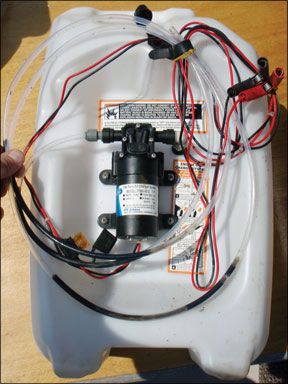
The sliding switch is easily seen, very simple, and can be moved with gloved or numb fingers.
Bad news:
We wish the strap-keepers on the sides of the Firefly units were a trifle more spacious so that small line or other forms of strap, webbing, for example, could be accommodated.
On balance:
This little gizmo, mounted on our PDF along with a loud whistle, gives us some peace of mind, and will be a lot better than nothing if we go overboard at night. However, considering what we know about how all such lights test in even mild real-world conditions were planning an upgrade to the SOLAS-rated Firefly 3, which has a redesigned lens and xenon strobe to make a higher intensity flash.
Force 10 Seacook
Single-burner stove
Reviewed March 2002 and July 2006
In our March 2002 report on five single-burner stoves, we liked both the Force 10 Seacook and the Forespar Mini-Galley among the gimbaled models. The Forespar didnt accommodate big enough pans, and we thought the Force 10 took too much time to boil water. In our July 2006 issue, we rated the Seacook as the Best Choice among seven models. Weve kept the Force 10 stove from the 2002 test and have used it for seven seasons aboard out test boat.
Good news
The Force 10 Seacook has rated well over the years because its a good design built out of good materials. The Force 10 uses 1-pound bottles of propane at a very reasonable rate, depending on the valve setting-low, medium, or high. On the high setting, it boils a full kettle of water faster than our home stove. We like stoves that use propane because the fuel is cheap and widely available. (That said, for those who prefer a somewhat safer, slower-cooking fuel, the well-made Origo alcohol stove has also rated highly in PS tests.)
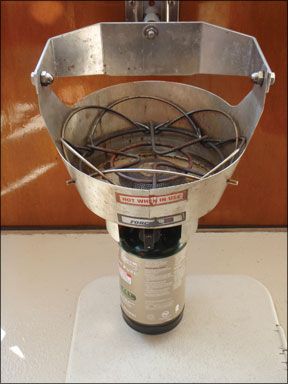
The test boat is small and there can be a lot of motion. The gimbal system is reliable on three axes, and is stubbed on one axis by the engine box. Luckily we have not had to cook while climbing and pitching down 10-foot waves.
The stainless steel is, in fact, somewhat stained, but there is no rust. The valve mechanism still works well, and all fasteners and threads are in good shape.
Bad news: Technically, this product does not comply with American Boat and Yacht Standards for cooking in an enclosed space. By that standard, its self-contained propane fuel canister is too large, and poses a fire risk. This fact, and lack of demand, led to the product being discontinued. Its a shame. Aside from the stains in the metal, we have little to complain about. The design and performance of the stove are solid. Ours is mounted low on the forward end of the engine box, under the overhead, so that one can sit and cook in the rain if necessary.
On balance:
We would buy this stove again, although the way this one is working, we probably wont have to.
Filter boss
Reviewed April 2007
While theres no “good” time for a clogged fuel filter, it always seems to happen at the worst possible moment, like running a rough inlet when wave action stirs-up long dormant crud from the bottom of your tank. For situations like these, a dual primary filter installation (which allows you to quickly switch from one filter to the other) can give you some extra running time, possibly making the difference between getting through that inlet or not. In February of 2007, we installed the FilterBoss, a pre-engineered, dual filter system from KTI Systems. The unit we installed comprises a FilterBoss unit (with wiring harness) and two Racor 500FG filters mounted on a pre-drilled, composite panel – price is $1,600. FilterBoss has a new Commander system ($2,100) that lets you switch filters remotely.

0)]
Good news: The unit we installed was well designed, robust, and has worked great for over three years. The unit also works well as a fuel-polishing system and makes it a breeze to purge the fuel system of air during our annual change of fuel filters without bleeding the lines.
Bad news
:The DIY with some experience could put together a comparable polishing system for about 2/3 the price. The key item, though, is the heavy duty pump with built in pressure gage and switching valves ($975), and even the Racors new Fuel Polishing Model, which is just a pump and a timer, goes for $600. Add filters, gauges, and assembly and the FilterBoss price doesn’t look so ]daunting.

1)]
On balance: Its important to note that if the primary filter clogs in heavy weather, the second filter may do the same in short order (depending on the level of gunk in your tank or fuel contamination). In other words, a dual-filter system is a handy option to have, but is no substitute for clean tanks and taking on clean fuel. Although weve had no harrowing situations where clogged fuel filters could have caused our demise, weve no doubt the FilterBoss unit will work as advertised if that time ever comes, and we welcome the peace of mind it provides.
Aere fender
Reviewed July 2008
The Aere fender by Praktek received high marks in our 2008 inflatable fender head-to-head test. The fender reviewed in the article was the 12-inch by 29-inch model (currently $149), however the manufacturer also provided an assortment of larger fenders to place in our long-term testing program. The 12-inch by 29-inch fender has been in use as our test boats primary fender since July 2008. Thats 27 months of constant use while at the slip, rafted up with other boats, etc. The larger fenders have also seen their fair share of abuse while visiting rickety transient docks, traveling through locks, etc.
Good news:
All of the AERE fenders are extremely light and easy to work with. Theyre also exceptionally tough, and while our primary fender shows some scuffing, no appreciable wear or damage was noted. The larger fenders are a cinch to stow when deflated, yet easily inflate to place an impressive degree of cushion and protection where needed.

2)]
Bad news:
As with the Easystow fenders, the air in the Aere expands in hot weather and deflates a bit in cold weather it, however this seems to be a minor issue. We can typically find a happy medium pressure-wise and seldom have to make adjustments for months on end. The valves are a bit more complex than most fenders, but theyre of high quality, and we had no trouble with them.
On balance:
After more than two years of service in a wide variety of uses, these fenders are holding up well. To this point, the Aere fenders have shown excellent resistance to abrasion and UV damage. We also like the fact that if they are damaged, theyre easily owner repaired using readily available glue and patches. Theyve delivered great performance so far, and we look forward to using them for years to come.
Boatsense
Reviewed August 2008
No matter how careful we are, all boaters have some degree of anxiety when leaving our vessels unattended in a slip, mooring, at anchor, or even while hauled out. As such, there are a number of vessel monitoring systems available to soothe the nerves of an absent, worried boat owner. In March of 2008, we installed a Boatsense Remote Vessel Monitoring System aboard our test boat.

3)]
Boatsense is a cellular phone based system that can send text messages to up to three cell phones and is available in two models: Boatsense ($600) and Boatsense GPS ($1,000). In addition to monitoring bilge water level and battery conditions, it can also monitor up to three additional alarm systems (fire, intrusion, etc.). The Boatsense GPS unit features a GPS monitor that provides drift alarms and coordinates, which means owners can easily locate their boat if it is stolen, or have the boat call them if the anchor drags or the boat breaks free from a mooring.
Good news: The Boatsense unit is compact (roughly the size of a deck of cards), easy to install, and robustly constructed, with no keypads, etc, to fail.
Bad news: While cheaper than most monitoring systems, $600 or $1000 isn’t chump-change for most sailors, particularly when you add in the $180 per year subscription fee. It also works only in areas with cell phone coverage.
On balance: After more than two years of use, the Boatsense unit has performed flawlessly and as advertised. While weve been lucky enough not to test the unit as a result of flooding or theft, it has warned us on at least two occasions of low battery voltages due to equipment left switched on after returning to the slip. We like the simplicity and reliability of the Boatsense unit, but wed like to see some way of reducing or eliminating the annual fee-maybe an option to simply add the unit to an existing cell phone plan?







































